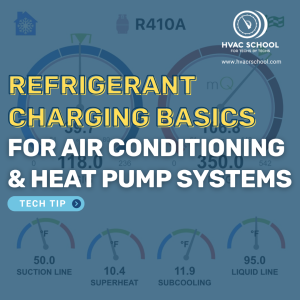BACK
 I’ve Done It This Way for 20 Years – And That’s the Problem
I’ve Done It This Way for 20 Years – And That’s the Problem
 What Should My Superheat Be?
What Should My Superheat Be?
 Best Practices to Conserve A2L Refrigerants in a Shortage
Best Practices to Conserve A2L Refrigerants in a Shortage
 Refrigerant Charging Basics For Air Conditioning & Heat Pump Systems
Refrigerant Charging Basics For Air Conditioning & Heat Pump Systems
 Solving Superheat
Solving Superheat
 Valve Core Removal Tools
Valve Core Removal Tools
 What Should My Subcooling Be?
What Should My Subcooling Be?
 Which Hose Do I Use?
Which Hose Do I Use?
 Weighing Refrigerant In and Out
Weighing Refrigerant In and Out
 Setting a Refrigerant Charge by Subcool
Setting a Refrigerant Charge by Subcool
 An R-454B Ramble w/ Elliot
An R-454B Ramble w/ Elliot
 Residential & Rack Startup and Commissioning (Part 1)
Residential & Rack Startup and Commissioning (Part 1)
 Checking a Heat Pump in Heat Mode – Short #178
Checking a Heat Pump in Heat Mode – Short #178
 Low Ambient, Condenser Flooding and Headmaster Valves Podcast Companion
Low Ambient, Condenser Flooding and Headmaster Valves Podcast Companion
#charging
Tech Tips:

Every trade has its favorite phrases. One of the most common in HVAC goes something like: “I’ve been doing it this way for 20 years and never had a problem.” When you hear that—or when you catch yourself saying it—it’s worth stopping to think. Usually, what that sentence really means is: “I’ve been doing it […]
Read more

The most common—and often most frustrating—questions that trainers and senior techs get asked sound something like this: “What should my ______ be?” or “My _____ is at ______. Does that sound right?” Usually, when the conversation is over, both the senior and junior techs walk away feeling frustrated because the junior tech just wanted […]
Read more

If you own your HVAC company or are involved in management, you may have realized that our industry is currently facing a shortage of new A2L refrigerants, particularly R-454B and R-32. Our own company has faced limited availability and long lead times, mainly due to supply chain disruptions and the increased demand now that our […]
Read more

Before I start on this one… At HVAC School, we focus on a wide range of topics. Many of them are very basic. My experience as a trainer for over 20 years has taught me that no matter what I assume others SHOULD know, it doesn't change the fact that they often do not. This […]
Read more

In this article, we’ll discuss solving superheat using this diagnostic sheet to help us better understand how it is calculated and from where it is derived. I want to thank Ty Branaman for helping me develop these sheets that will hopefully aid in a better understanding of some of the basic HVAC measurements that both […]
Read more

Valve core removal tools were originally developed to remove damaged valve cores without the need to pump the system down. This technology was a major leap forward in work efficiency, as pumping down a system can be a tedious and time-consuming task. Eventually, technicians discovered that removing valve cores led to faster evacuation, recovery, and […]
Read more

This is the article you read BEFORE you call and ask a senior tech what your subcooling should be. It's also the one you send to a junior tech when they call and ask you: So, what is subcooling? (Or subcool, as many call it.) Subcooling is a measurement of the temperature DECREASE of a […]
Read more

This tech tip is a companion piece to a recent short podcast episode about the same topic. It contains links to the specific products mentioned in that podcast. You can also learn more about NAVAC products as a whole at https://navacglobal.com/. Our trade has a lot of cool tools. But while we’re thinking about how […]
Read more

If you don't use a scale every time you add or remove refrigerant, I suggest you begin doing so immediately, if not sooner. Weighing in while charging is fairly obvious, and it's useful so you can keep track of what you are using and how much to charge a customer. When you have a system […]
Read more
Videos:

Bryan demonstrates an in-depth tutorial on how to set a refrigerant charge by Subcool.
Read more
Podcasts:

In this raw and unfiltered episode, Bryan sits down with Elliot, a senior service tech and newly minted install supervisor, to discuss the realities of working with R-454B refrigerant in the field. What starts as a technical discussion about the new A2L refrigerant quickly evolves into a candid conversation about industry frustrations, manufacturer accountability, […]
Read more

In this episode of the HVAC podcast, Bryan and Max Johnson from Kalos discuss the critical role of a startup and commissioning technician in the HVAC industry. Max, who has experience in both residential and commercial HVAC, shares his insights on the importance of understanding the scope of work, equipment specifications, and code requirements. […]
Read more

In this short podcast, Bryan talks about checking the charge of a heat pump in heat mode. This skill will become more critical as ambient temperatures get cooler. The most reliable way to check and set the charge regardless of operating mode and season is to weigh the charge. This method is most practical […]
Read more

Today, Jeremy Smith joins us to discuss low-ambient conditions and controls, condenser flooding, and headmaster valves. He has also given us a companion article on those subjects, which you can read below. Download the podcast directly HERE. As always, if you have an iPhone, subscribe HERE, and if you have an Android phone, subscribe HERE. […]
Read more













